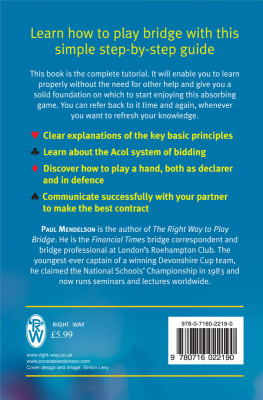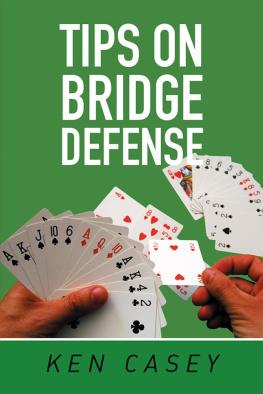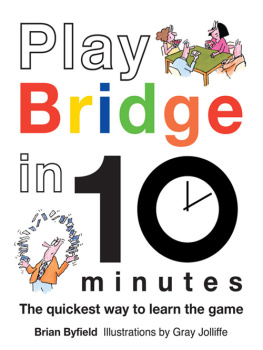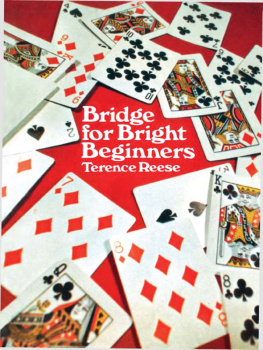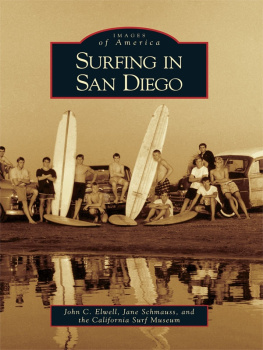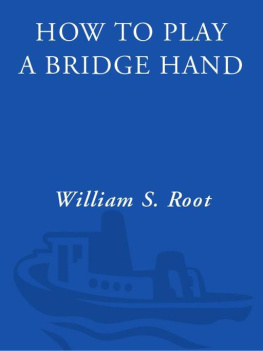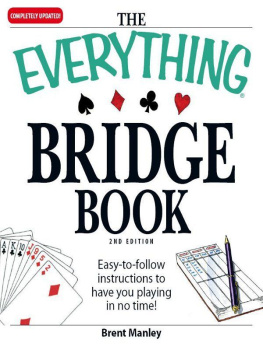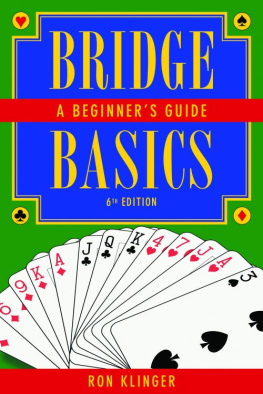BRIDGE
| "Soon as she spreads her hand, the aerial guard |
| Descend and sit on each important card." |
B R I D G E
ITS PRINCIPLES AND RULES
OF PLAY
BY
J. B. ELWELL
colophon
WITH ILLUSTRATIVE HANDS AND THE
CLUB CODE OF BRIDGE LAWS
NEW YORK
CHARLES SCRIBNER'S SONS
1906
COPYRIGHT, 1902, 1905, BY
J. B. ELWELL
TROW DIRECTORY
PRINTING AND BOOKBINDING COMPANY
NEW YORK
TO HIS PUPILS
AND TO
ALL OTHERS INTERESTED IN
THE GAME OF BRIDGE
THE AUTHOR
WOULD BEG LEAVE TO DEDICATE
THIS BOOK
PREFACE
THE main purpose which I have had in view in writing this book has been to provide my pupils with a SIMPLE and ELEMENTARY work on Bridge. I have endeavoured to abstain from assuming a knowledge of Whist or Whist terms on the part of the reader, and have merely attempted to write a text-book which shall combine clear and concise statements of my rules, with a reason for and explanation of each one. These rules have stood the test of practical experiment by myself and others for the last five years, so that this statement of them will, I trust, be of benefit both to the beginner and to the advanced player.
J. B. E.
BRIDGE
PLAYERS
Bridge is usually played by four persons. If there are more than four candidates, the prior right to play is decided by cutting the cards.
CUTTING
This is done from a full pack of fifty-two cards which have been shuffled and spread face downward on the table. Each player draws a card. The four cutting the lowest cards play the first rubber. In cutting ace is low. The cards are also cut to decide partners, the two highest playing against the two lowest. The dealer is the player cutting the lowest card of all, and he has the choice of the seats and of the cards. Should the two players who cut the lowest cards draw cards of equal value, they must cut again to decide which shall deal.
DEALING
Before being dealt, the cards must be shuffled by the dealer and then cut by the player at his right. It is customary to play with two packs of cards, the dealer's partner shuffling, or making up, for his right-hand adversary. The cards are dealt one at a time, from left to right, until all are exhausted, each player having thirteen cards. The last card should not be turned face up. There is no penalty for a misdeal.
THE OBJECT OF THE GAME
There are two separate scores to be played fortrick and honour scores. The trick score is credited to the side that wins more than six tricks; the honour score to the side that holds the majority of the trump honours. The object of the game is to score more points than your adversaries, tricks and honours included. This is best done by winning a rubber.
THE GAME
The game consists of thirty or more trick points. All points in excess of thirty are counted by the side winning them; but only one game can be won in a deal. Honours are a separate score and do not count toward winning the game.
THE RUBBER
The rubber is the best of three games. If the first two games are won by the same partners the third is not played. One hundred points are added to the total score of the side winning the rubber.
DECLARING THE TRUMP
The hand may be played either without a trump, or a trump suit may be selected.
The dealer has the option of making a declaration or of passing that privilege to his partner. If the dealer passes the make, his partner must announce the trump. A trump once made cannot be changed at any time during the deal.
TABLE OF TRICK VALUES
(For each trick over six.)
| When | are trumps each trick counts | 2 |
| When | are trumps each trick counts | 4 |
| When | are trumps each trick counts | 6 |
| When | are trumps each trick counts | 8 |
When
there
are | no | trumps each trick counts | 12 |
DOUBLING
After the trump has been declared each adversary, in turn, may increase the value of the tricks by doubling.
The leaderthe player at the left of the dealerhas the first right to double. If the leader does not wish to double his partner may then do so.
REDOUBLING
If either the leader or his partner has doubled the trump, the dealer or his partner may re-double, the player who has made the trump having the first right. This process may continue indefinitely. Doubling or redoubling does not affect the value of the honours.
THE DUMMY
When the value of each trick has been determined, and after a card has been led, the dealer's partner places his hand face upward on the tablethe trump suit at his rightand the dealer plays both hands. The dealer's partnerthe dummyis not allowed to suggest, to touch or to play a card except at the dealer's bidding. It is the dummy's right, should the dealer refuse to follow in any suit, to endeavour to prevent a revoke. (See Conversation of the Game.)
THE PLAY
In the play of the cards the ace is high and deuce low. You must follow suit, but if you have no card of the suit led, you may either trump or discard. At no-trump the best card of the suit led wins the trick.
THE CONVERSATION OF THE GAME
In order to avoid giving partner information as to the character of one's hand, both the conversation of the game and its order should be strictly adhered to. To find that the wrong person has announced the trump, or that a player has doubled out of turn, or that one has led without asking permission, is most irritating to the other players, and a severe penalty may often be exacted for such a mistake. The dealer may either declare the trump or say, "I pass." If the dealer passes, his partner must announce the trump. The leader may either double or say, "May I Lead, Partner?" this indicates that he does not want to double, but wishes to give his partner an opportunity to do so. The leader's partner either says "No, I double," or "lead, please."
The conversation is indicated in the following diagram.
"May I lead?
or
"I double." | "Spades,"
or
"I make it Spades." |
Y
Dummy |
| A Leader | B | "No, I double,"
or
"Play, please." |
Dealer
Z |
"I make it Hearts,"
or
"I pass." |
When the trump has been doubled the maker says, "I redouble," or "I am satisfied." If the maker is satisfied his partner says, "I redouble," or "I am satisfied." In many clubs the conversation is somewhat changed and abbreviated. "Pass." "Hearts." "I double." "I go over." "I redouble" or "I go back." "Enough," or a rap on the table to signify satisfaction.
TO PREVENT A REVOKE
If your partner refuses to follow suit, always ask, "Have you no (hearts), Partner?" An error may then be rectified, but only before the trick has been turned and quitted or before another card has been led.
SCORING
The score consists of two separate counts: trick score and honour score. The trick score is made by the side winning more than six tricks in a hand. The honour score, by the partners who hold the majority of the trump honours. With a declared trump the honours are A K Q J and 10. At no-trump only the Aces count as honours. Doubling does not increase the honour score.



